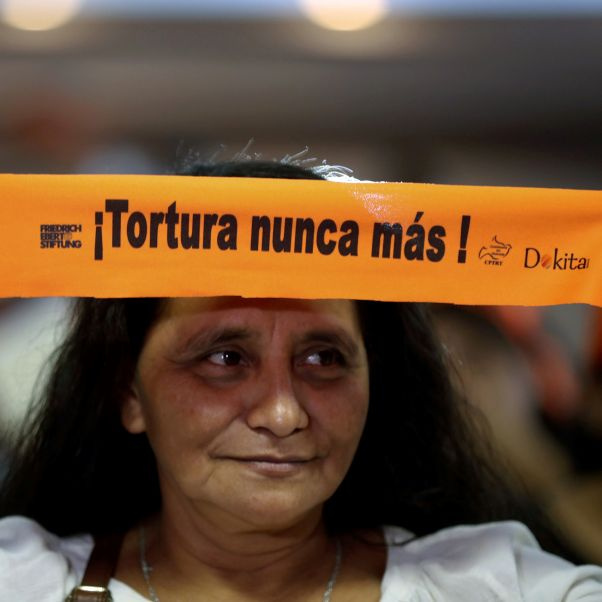Breadcrumb

COMMITTEE AGAINST TORTURE CONSIDERS FOLLOW-UP TO CONCLUDING OBSERVATIONS, INDIVIDUAL COMMUNICATIONS, AND REPRISALS

The Committee against Torture this afternoon discussed follow-up to concluding observations, individual communications, and reprisals under the Convention against Torture and other Cruel, Inhuman or Degrading Treatment or Punishment.
Abdelwahab Hani, Rapporteur on follow-up to concluding observations under article 19 of the Convention, presenting his report, said that they had looked at some good practices concerning Seychelles, Cameroon and Qatar. Reminder letters had been sent to Belarus, Qatar, Mauritania and Seychelles, and evaluation letters had been sent to Bosnia and Herzegovina, Norway, Pakistan, Senegal, Chile and the Republic of Moldova. Evaluation reports had been prepared for Chile, Republic of Moldova, Czech Republic, Maldives and Qatar. The evaluation reports referred to the response of the States parties as well as the degree of implementation of the Committee’s recommendations.
Mr. Hani said his mandate was coming to an end on 31 December, so this was his last follow-up report. He wished to talk about some lessons learnt during his four years as Rapporteur on follow-up to concluding observations under article 19 of the Convention. First was the importance of choosing recommendations that were specific, realistic and measurable. Second was the importance of adhering to the Committee’s guidelines from December 2015 and to abstain from recommendations that required legislative measures, because the legislative process took a lot of time. Third was the importance of restricting follow-up recommendations to three or four recommendations maximum, and avoiding recommendations with several paragraphs. Fourth was the importance of specifying precisely in the text of the recommendation the nature of the recommendation itself. Fifth was the importance of specifying at the conclusion of the review the General Comments of the Committee, as well as the relevant soft laws.
The Chair of the Committee, Jens Modvig, said that of course the Committee would like to see all its recommendations adopted within a year, but the results were not bad. What was the reason that the recommendations were not fully implemented? Did this concern the will of the State party, or was it the Committee’s fault if it chose recommendations that were too lengthy to fully implement?
In response, Mr. Hani said he believed this was about shared responsibility. The need for specific recommendations was necessary on the part of the Committee. Also, the Office of the High Commissioner for Human Rights could help States with capacity building. It was also the responsibility of all entities that took part in any training to ensure that the follow-up process was fully part of the reporting process.
Claude Heller Roussant, Rapporteur on follow-up to individual communications, said that during the session, the Committee looked at 11 individual communications. Concerning Switzerland, three communications were finalized with a satisfactory solution and full implementation of the Committee’s recommendations. Concerning two communications from Sweden, there was satisfactory resolution of one, and for the other, it was decided to continue the dialogue with the State party. For Denmark concerning one communication, there was a lack of implementation by Denmark, so the Committee decided to continue its dialogue with the State party to move forward. For Morocco, there were two individual cases. As there was a lack of implementation of the Committee’s recommendations, it would continue with the dialogue with the State party to move forward. For Argentina, one communication had been assessed in which there was partial implementation of the Committee’s decision, so the Committee would continue with the dialogue with the State party. For Bosnia and Herzegovina, the Committee considered one case in which there had been partial implementation of the Committee’s decision. Some progress had been registered and the Committee would continue with its dialogue with the State party. For Mexico, the Committee considered one case in which it decided there was lack of implementation, and the Committee decided to continue its dialogue with the State.
The Rapporteur on follow-up to reprisals, Ana Racu, said that since the last session, four cases had been in the focus of the Committee, two cases against Morocco, one against Argentina and one against Mexico. Concerning one case against Morocco, the Committee had decided to keep the follow-up dialogue ongoing and to send a reminder to the State party. As for the second one, the Committee decided to keep the follow-up dialogue ongoing and to request a meeting with the Permanent Mission of Morocco in Geneva. Concerning the case against Argentina, the follow-up dialogue would continue. As for the case against Mexico, the follow-dialogue would continue and there would be a letter sent with a renewed request for protection measures. There were no new allegations of reprisals.
Bakhtiyar Tuzmukhamedov, Committee Expert from Russia, said during the review of the report of Uzbekistan, there had been a considerable Russian presence in the conference room. The Chair had not been properly informed about their presence. The Russian Foreign Ministry and the Office of the High Commissioner for Human Rights had been bringing in groups of senior Russian civil servants for orientation tours after Russia’s report was considered by the Committee last year. This time the group was very much focused on torture. When he returned home, he would ask the State party to send a group from the regions and not the capital, with participants who were concerned with issues of racial discrimination as Russia was a multi-ethnic State.
All the documents relating to the Committee’s work, including reports submitted by States parties, are available on the session’s webpage. The webcast of the Committee’s public meetings can be accessed at http://webtv.un.org/.
The Committee will next meet in public at 10 a.m. on Friday, 6 December, to publicly close its sixty-eighth session.
For use of the information media; not an official record
CAT19.025E
